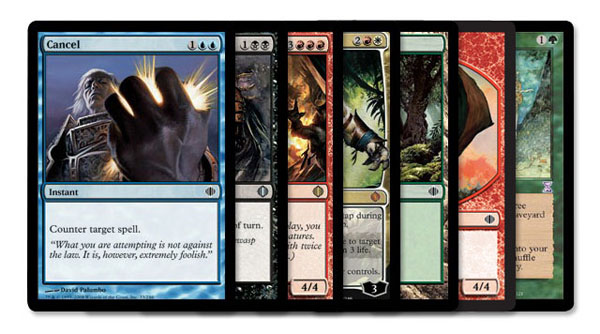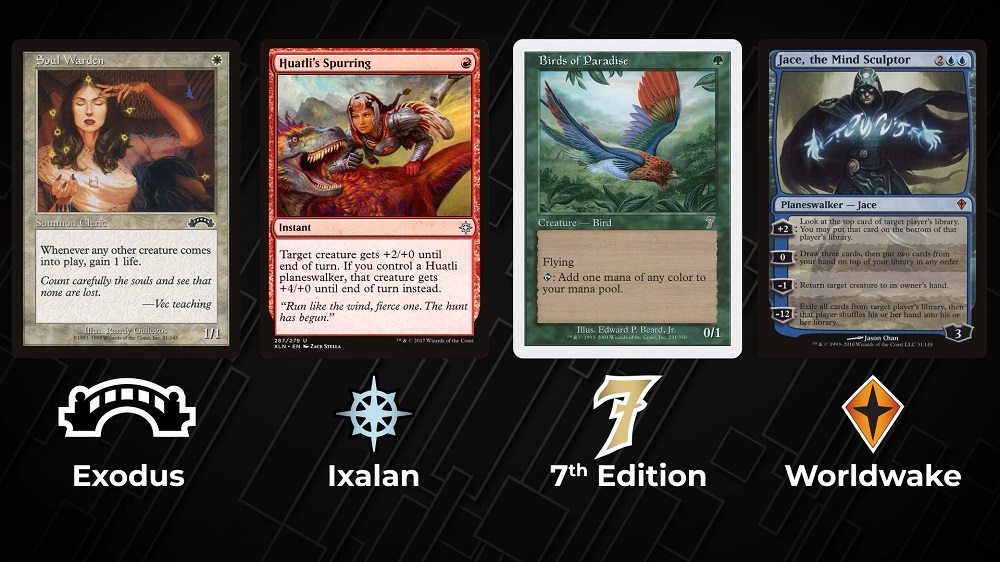The Rarities Of Magic: All About Cards From Common To Mythic
For decades, this iconic game has captivated players with its intricate gameplay, imaginative world-building, and, of course, its vast array of cards. These cards come in a variety of rarities, each denoting their scarcity and power. From the humble Common to the awe-inspiring mtg rarity of a card often dictates its value, desirability, and impact on the game.
Author:Georgia AshcroftReviewer:Ava MartinezSep 01, 2023106.9K Shares1.5M Views

In the enchanting realm of collectible card games, few titles hold as much allure and mystique as The Rarities of Magic: All About Cards from Common to Mythic. For decades, this iconic game has captivated players with its intricate gameplay, imaginative world-building, and, of course, its vast array of cards.
These cards come in a variety of rarities, each denoting their scarcity and power. From the humble Common to the awe-inspiring mtg rarityof a card often dictates its value, desirability, and impact on the game. Join us as we delve into the mesmerizing hierarchy of card rarities within Magic - The Gathering.
What Is A Card’s Rarity?
As the name suggests, a card's rarity describes how simple it is to get from booster packs. MTG cards may be classified as common, uncommon, rare, or mythic rare.
Let's review before we continue. The color of an expansion symbol on a card represents the rarity of that card. The card's color and symbol both reveal the set to which it belongs and its level of rarity. The symbols for common, uncommon, and rare cards are black and white, silver, and gold, respectively. The rarest cards you can discover are mythic rares, and they contain a bronze emblem.
Common
In the MTG community, common cards are the most prevalent. Every time you open a fresh pack, you'll find lots of them. They normally aren't very eye-catching, but they serve as the framework for your decks. Even some of them outperform cards of greater rarity. After all, you don't just witness lightning bolts whizzing about by accident.
Uncommon
Every time you open a pack, you acquire three unusual cards, which are often more valuable than common cards. Although they are hardly game-changers, you'll utilize them as the foundation of your decks. Some uncommon, like Risen Reef, may be rather difficult to handle. Even to the extent that the majority of players design their whole deck around cards similar to it while ignoring rares and mythic rares. Common cards are often simpler than uncommon cards.
Rare
MTG cards really start to shine in this situation. Rare cards are identified by a golden emblem and are often extremely strong. They may be quite simple, like a board wipe like Planar Cleansing, or they can be a little more complex but still highly effective, like Snapcaster Mage.
Mythic Rare
The last rarity is legendary rare. These are the hardest to find, yet they often change the game. You won't acquire many of them since they only have a 1/8 chance to replace rare cards in any pack.
Having stated that, anytime you discover a sleeve, you must place them inside. Even if you don't utilize them in your decks, they are still incredibly useful. Since there aren't many mythic rares in each set, you have a little higher chance of finding the one you desire when you get one.
What Special Rarities Are There?
In the captivating world of Magic - The Gathering, the standard hierarchy of card rarities, from Common to Mythic Rare, provides a robust framework that shapes gameplay and collectibility.
However, beyond this well-established hierarchy, there exist special rarities that add an extra layer of excitement and exclusivity to the game. These special rarities introduce unique mechanics, thematic resonance, and innovative approaches that diversify the Magic experience.
Masterpiece Series - A Showcase Of Artistry And Power
The Masterpiece Series, also known as the Expedition, Invention, and Showcase frames, represents an extraordinary departure from the standard card rarities. These special sets spotlight cards with incredible artwork, thematic framing, and often alternate frames that bring new life to classic cards.
The Masterpiece Series isn't bound by the traditional rarity hierarchy; instead, it showcases cards from different rarity tiers that share thematic resonance or extraordinary power. For instance, in the Expedition Series, players can find stunning full-art land cards that depict iconic Magic landscapes in unprecedented detail.
These cards are highly sought after by collectors for their artistic value and their ability to enhance the visual appeal of a deck. The Invention Series showcases artifacts with intricate detailing and unique frame treatments, offering a new way to appreciate the game's mechanics.
Timeshifted Cards - Nostalgia Rewoven
The concept of timeshifted cards was introduced in the Time Spiral block, bringing a touch of nostalgia to the game. These cards hark back to the past, resurrecting old mechanics, abilities, and even card frames from earlier Magic sets.
Timeshifted cards are characterized by a unique card frame that sets them apart from the regular cards in a set, creating a visual distinction that emphasizes their special nature.
These cards not only introduce a sense of nostalgia for veteran players who remember the cards from their original releases but also provide newer players with an opportunity to experience Magic's history and evolution. Timeshifted cards create a bridge between Magic's past and present, making them treasured additions to any collection.
Extended Art Cards - Expanding Aesthetic Horizons
Extended art cards offer an alluring twist on traditional card designs. These cards feature artwork that extends beyond the standard frame, enveloping the card's borders in a visually captivating manner.
This extended artwork allows artists to explore their creativity more expansively, offering players a fresh perspective on familiar cards. Extended art cards often accompany special sets or premium products, making them both desirable and exclusive.
Collectors and players alike appreciate extended art cards for their unique visual appeal, as they transform well-known cards into stunning masterpieces. The extended art format not only provides artists with a larger canvas to tell their stories but also gives players a chance to see beloved characters and creatures in a new light.
How To Tell A Card’s Edition
The "Edition 1" mark, which often appears on the card's reverse side (or adjacent to it in early Japanese 1st Edition sets), serves as a visual cue that the card is a 1st Edition. Additionally, the booster packs and boxes for the first edition include this insignia.
Generally speaking, first editions with the initial printings will be the most valuable. You'll mostly be searching for hardcover books, depending on who published the book and in what versions. However, not all hardcovers will be first editions.
Card Set Symbols - The Key To Identification
The most reliable and straightforward way to identify a card's edition is through its set symbol. Every Magic expansion, core set, or special release features a distinct set symbol that is prominently displayed on the card. This set symbol acts as a visual identifier, allowing players and collectors to quickly recognize which set a card belongs to.
Set symbols are often thematic, tying into the overarching concept of the set. They can depict anything from a magical icon representing the set's themes to an emblem associated with a particular faction or world. By learning to recognize these symbols, players can effortlessly differentiate cards from different sets and gain insights into the narrative and mechanics behind each expansion.
Collector's Number And Rarity - Tracing Editions
Another way to determine a card's edition is by examining its collector's number and rarity. Each card within a set is assigned a collector's number that corresponds to its position within the set's card list. This number provides valuable information about a card's place in the set's structure and its relative scarcity compared to other cards.
The collector's number can be accompanied by an abbreviation denoting the card's rarity, such as "C" for Common, "U" for Uncommon, "R" for Rare, or "M" for Mythic Rare. By understanding the correlation between collector's numbers and rarities, players can identify cards within an edition and gain insights into their potential value.
Copyright Dates - Navigating Time Travel
Magic - The Gathering is renowned for its intricate storyline and evolving world-building. As a result, cards often depict characters, creatures, and events that are specific to certain periods in the game's lore. By observing the copyright date on a card, players can discern when the depicted events took place within the game's narrative timeline.
This can be particularly relevant when cards reference specific story arcs, planes, or characters that were introduced in previous editions. The copyright date acts as a temporal anchor, allowing players to appreciate the interconnectedness of the game's storylines and its ever-expanding universe.
How To Check A Card’s Value
It would be hard to miss the enduringly common practice of exchanging single playing cards for cash. While purchasing a booster pack may allow you to get 16 cards for a few dollars if you know which cards are included, you may research the potential value of each card individually.
Common and Uncommon cards often don't sell for enough to warrant further investigation into their value, but with Rare and Mythic cards, particularly if they are Foil or any other unusual sort of card, there is a possibility that they may be sold for a greater price.
The condition that the card has been maintained also affects the sale of these cards. If a card gets folded in half and dog-eared after being hidden beneath a sofa for years, its value will start to drastically decline even if it is in perfect shape.

How To : Magic card rarity type how to spot them and what they mean
Are Rare Magic Cards Better Than Commons?
A card with a greater rarity will, as a general rule, have more significant in-game effects than one with a lower rarity. However, regardless of rarity, the top Magic players utilize whichever cards fit their deck the best!
The demand for a card among players determines its price; the more individuals who want it for their decks, the higher the price will rise. The additional scarcity will often drive up the price more if the card is a Rare or Mythic Rare. However, Commons and Uncommons may still fetch a decent price, particularly if every player wants four copies!
The best course of action is to go to your neighborhood card store if you're seeking for a particular card or want to know how much your collection is worth. These are often privately held companies that value, purchase, sell, and exchange Magic cards. If there isn't a store nearby, consider going to an online retailer like TCGPlayer, CardMarket, or Channel Fireball.
People Also Ask
What Role Do Common Cards Play In Magic - The Gathering?
Common cards form the foundational building blocks of decks, offering essential mechanics and creatures to players.
How Do Uncommon Cards Differentiate Themselves From Common Cards?
Uncommon cards introduce more complex abilities and strategic options, offering a bridge between accessibility and uniqueness.
What Defines The Impact Of Rare Cards In The Game?
Rare cards are pivotal in shaping deck strategies, often housing game-changing abilities that influence gameplay dynamics.
What Sets Mythic Rare Cards Apart From Other Rarities?
Mythic Rare cards, the pinnacle of rarity, possess exceptional power and scarcity, making them prized possessions among players.
How Do The Special Rarities In Magic Contribute To The Experience?
Special rarities like Masterpiece Series and Signature Spellbook celebrate artistry, characters, and history, enriching gameplay with thematic resonance and visual allure.
Conclusion
Delving into the intricacies of Magic - The Gathering reveals a world where cards are not just components of gameplay, but artifacts that carry within them the essence of the game's evolution, storytelling, and strategic depth. "The Rarities of Magic: All About Cards from Common to Mythic" serves as the foundation upon which this captivating universe is built.
From the unassuming Common cards that provide the groundwork for decks to the rare and coveted Mythic Rares that reshape the battlefield, each card mtg rarity tier contributes to a dynamic tapestry that engages players, collectors, and enthusiasts on multiple levels.

Georgia Ashcroft
Author
Georgia Ashcroft is a seasoned astrologer and spiritual practitioner with over 5 years of experience. She holds a Master's degree in Physics from Princeton University, enriching her astrological insights with a deep understanding of scientific principles.
Georgia's published works encompass insightful analyses of astrological phenomena, including zodiac signs and horoscope interpretations, establishing her as an esteemed figure in astrological circles.
Beyond astrology, Georgia is passionate about tarot and regularly incorporates its wisdom into her spiritual practice.

Ava Martinez
Reviewer
Ava Martinez is a highly experienced author specializing in spirituality and tarot. With over 12 years of dedicated practice, Ava brings a wealth of experience and expertise to her writings.
She has dedicated herself to helping individuals gain insight and clarity through spiritual practices and tarot consultations.
Her deep connection to spiritual energies and engaging style make her readings a trusted resource for those seeking guidance and enlightenment.
Apart from her literary world, Ava embraces nature's gifts, explores meditation's depths, and intertwines the mystical essence of spells into her holistic perspective on life's journey.
Latest Articles
Popular Articles

